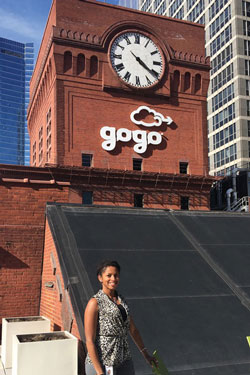Taking the Internet Sky High
Kristin Richardson (’09) helps pilot Gogo’s effort for speeding up inflight Wi-Fi performance.
 When Kristin Richardson sees fellow airplane passengers power up their mobile devices to get an online update on the latest world news or stock market tallies, she smiles. She knows she had a hand in making that inflight convenience a reality.
When Kristin Richardson sees fellow airplane passengers power up their mobile devices to get an online update on the latest world news or stock market tallies, she smiles. She knows she had a hand in making that inflight convenience a reality.
As an aircraft electrical engineer at Chicago-based Gogo, Richardson has worked to retrofit aircraft with Gogo’s 2Ku satellite-based, inflight Internet service. She began her career with defense contractor Northrop Grumman, moved on to Chicago’s S&C Electric, and then joined Gogo in the fall of 2016. Recently, she discussed with Northwestern Engineering magazine her ambitious effort to bring faster Wi-Fi to the skies.
Please describe your primary responsibilities with Gogo.
Essentially, my team is responsible for making sure that the design is in shape so there are few problems upon installation. We do a lot of wiring diagram reviews and load analyses and provide engineering support during design reviews and prototype installations.
What’s the scope of the 2Ku Project?
Gogo started by offering air-to-ground Internet service, which was functional but slow. The difference with 2Ku service is basically the difference between a dial-up modem and today’s faster Internet speeds. Right now, we’ve outfitted more than 100 airplanes with 2Ku, and the goal is to complete 1,400 installations by year’s end.
What do you find particularly exciting about this work?
This Gogo project excites me because it touches the general population. I did interesting work at Northrop Grumman, but it was classified. Similarly, you’d probably never know of the innovation going on at S&C unless you work for a utility. But, if you’re on a plane and using the Internet, it’s likely you’re interacting with the work we do at Gogo.
Has the project presented any unique challenges?
Learning the Federal Aviation Administration regulations and ensuring our equipment is compatible have definitely been exhausting, though understandably so. After all, we’re putting a hole in an airplane and making modifications to the aircraft, something we have to do without altering performance or safety.
Another big challenge is not having an opportunity to test things in a lab and get immediate confirmation. We have to do all of our homework up front because nobody’s grounding an airplane for a day or two so we can experiment.
How has your Northwestern Engineering education proven helpful?
In most cases, we don’t have all the information we need up front, so we have to be flexible, creative thinkers to develop solutions. That’s familiar to me. At Northwestern, I didn’t just plug data into an equation. Instead, I was challenged to trust my skill set and think at the next higher level.
